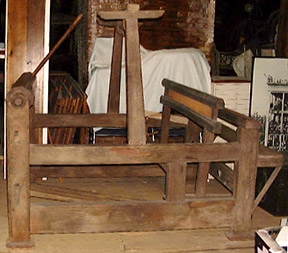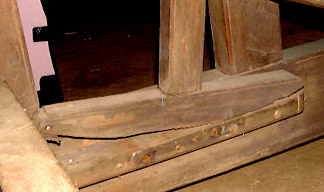|
Wide view of left side of loom. |
Loom has mid-loom supports for the shedding system, three treadles, a warp beam with bore staff, and a built-in weaver's bench. The beater frame rests on rocker runners located inside the loom frame.
The loom edges are embellished with a beading detail
commonly seen in German furniture making.
|
|
Norman Kennedy, former master weaver at Colonial Williansburg, and founder of a weaving School in Vermont, acquired the loom near Ashville, North Carolina, and transported it to New England in the 1970s. The loom's beaded edges lead Kennedy to believe the loom style may have been of German origin, hence the name "German Loom." However, extensive research has failed to uncover any evidence of pre-industrial standing beater looms in Germany. Another possible explanation for the beading detail is that a recent German immigrant built the loom, and embellished it in his own established way. No background information came with the loom, but Kennedy speculates it may have been built during the later part of the 18th century. He later sold the loom to a collector who, in turn, donated it to the Beverly Museum in the early 1990s. |
|

 At Right:
Detail of rocker and rocker runner. Evidence indicates the
rockers were originally kept in place on the runners with
leather straps (note leather fragment attached to
left-hand tip of rocker).
At Right:
Detail of rocker and rocker runner. Evidence indicates the
rockers were originally kept in place on the runners with
leather straps (note leather fragment attached to
left-hand tip of rocker).